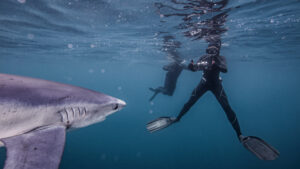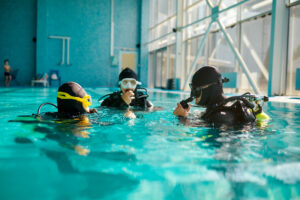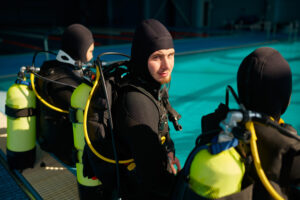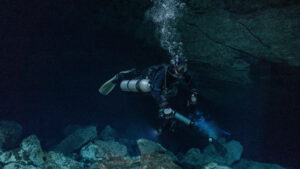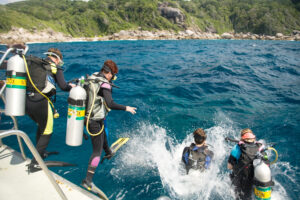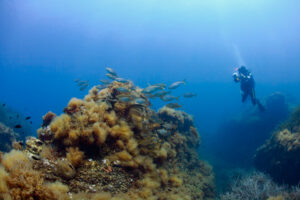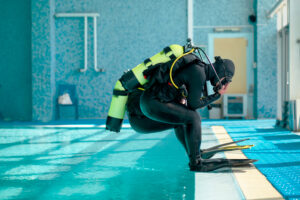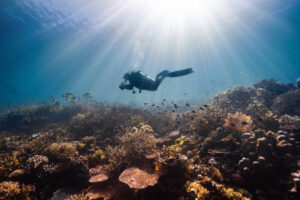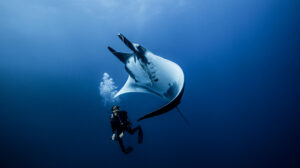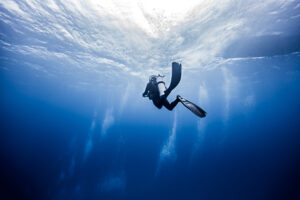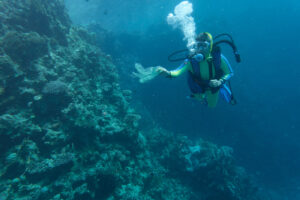Why do you need to be aware of the Tide when Diving?
Tides are a natural phenomenon characterized by the rhythmic and predictable rise and fall of sea levels. They are primarily driven by the gravitational forces between the Earth, the Moon, and to a lesser extent, the Sun. This interplay results in the movement of massive volumes of water across the globe, influencing ocean circulation, marine ecosystems, and human activities, including scuba diving. Understanding tides is essential for divers as it impacts various aspects of underwater exploration, from visibility and currents to the behavior of marine life.
Gravitational Influence and Tide Generation
The gravitational relationship between Earth and the Moon is the dominant force in the creation of tides. The Moon’s gravitational pull causes Earth’s water to bulge toward it, resulting in what we call a high tide. On the opposite side of the Earth, a second bulge occurs due to the centrifugal force produced by the Earth’s rotation. This dual bulge creates two high tides and two low tides each day in what is known as a semidiurnal tide pattern.
Though the Sun is much larger than the Moon, its distance from Earth reduces its gravitational influence on tides. However, the Sun does play a role, especially during certain lunar phases. When the Earth, Moon, and Sun align during the full and new moons, their combined gravitational forces produce what are called spring tides. These tides are higher than average and occur twice each lunar month. Conversely, when the Moon and Sun are positioned at right angles relative to the Earth, during the first and third quarters of the moon, the gravitational forces partly cancel each other out. This leads to neap tides, which are lower than average.
The combination of these gravitational interactions creates a cycle that divers must understand to predict water conditions. The predictable nature of tides allows for careful planning, helping divers avoid potentially dangerous situations caused by strong currents or limited underwater visibility. Thus, tides are not merely a cosmic occurrence but a critical aspect of the underwater environment.
Tidal Patterns
Tides do not follow a uniform pattern across the globe. Instead, they vary depending on geographic location and the ocean’s interaction with landmasses. There are three primary tidal patterns: semidiurnal, diurnal, and mixed.
The semidiurnal pattern, which features two approximately equal high tides and two low tides every day, is the most common. This pattern can be observed along many of the world’s coastlines, making it familiar to most divers. In a semidiurnal pattern, the intervals between high and low tides are predictable, offering a reliable schedule for planning dive sessions.
In contrast, diurnal tides occur when there is only one high tide and one low tide each day. This pattern is less common and is typically found in certain regions of the Pacific Ocean. For divers operating in areas with diurnal tides, understanding when the single daily tide will occur is essential for determining the best times to enter the water.
The third tidal pattern, known as mixed tides, presents a more complex scenario. Mixed tides feature two high tides and two low tides each day, but they are unequal in height. This pattern is seen in many parts of the world, including the U.S. Pacific coast. The variability in tidal heights can present unique challenges for divers, as the strength of tidal currents and the level of underwater visibility may differ significantly between tide cycles.
Understanding these tidal patterns is critical for divers, as the type of tide can affect not only the accessibility of certain dive sites but also the overall safety and quality of the dive. In regions with semidiurnal or diurnal tides, divers can more easily predict the timing of slack water, while those diving in areas with mixed tides may need to be more vigilant in monitoring local tidal charts to plan their dives effectively.
Tides and Scuba Diving
Tides play a significant role in determining the conditions divers face underwater. From visibility to currents, the timing and strength of the tide can influence nearly every aspect of a dive. Understanding how tides work can help divers avoid challenging or hazardous conditions and maximize their underwater experience.
Slack water, the period between high and low tides when currents are at their weakest, is generally considered the best time for diving. During slack water, the lack of strong water movement allows for clearer visibility, as sediment is less likely to be stirred up. It also reduces the risk of being swept away by strong currents, making it the safest time to explore underwater.
The period of incoming tide, known as the flood tide, often brings with it clearer water from the open ocean. This can significantly improve visibility, making it an ideal time for divers to explore. However, the flood tide also tends to bring stronger currents, requiring divers to exert more effort to maintain their position. These currents can sometimes be challenging for less experienced divers, emphasizing the importance of planning dives according to tidal schedules.
Conversely, the outgoing tide, or ebb tide, may bring sediment-filled water from estuaries or river mouths, reducing visibility. Divers can encounter murky conditions during this time, making navigation and spotting marine life more difficult. As a result, most divers prefer to avoid diving during the ebb tide, especially in areas where the water is likely to carry debris or sediment.
By planning dives around slack water, divers can minimize the impact of tides and ensure a safer and more enjoyable dive. Monitoring local tide charts is an essential skill for anyone looking to dive regularly, as even small changes in water movement can have a significant effect on diving conditions.
Tides and Marine Life
Tides influence not only the physical conditions of the ocean but also the behavior of marine life. For many underwater species, the rise and fall of the tide dictate feeding habits, migration patterns, and breeding cycles. Divers who understand the relationship between tides and marine life can increase their chances of encountering specific species.
During high tide, many marine animals move into shallower waters to feed. This period can be an excellent time for divers to observe fish and other species that are more active when the water is higher. For example, many predatory fish use high tide to access hunting grounds that are otherwise too shallow, while smaller fish and crustaceans take advantage of the increased water coverage to feed on plankton and other microorganisms.
In contrast, low tide exposes parts of the ocean floor, particularly in intertidal zones, where marine life can be easier to spot. During this time, certain species, such as crabs and starfish, are more visible as they emerge from crevices to scavenge for food. Understanding these behavioral patterns can help divers time their dives to coincide with peak activity for specific species, enhancing the overall experience.
For divers interested in marine biology, understanding the connection between tides and the behavior of marine life offers valuable insight. The timing of the tide can provide a unique opportunity to observe marine animals in their natural habitat, whether during feeding or other activities. In many cases, divers can plan their dives to maximize the chance of seeing particular species by anticipating their movement based on tidal changes.
Tidal Range and Local Factors
The tidal range, or the difference in height between high and low tide, varies significantly depending on the location. In the open ocean, this range may be less than 1 meter (3.28 feet), while near coastlines, it can exceed 10 meters (32.8 feet). One of the most extreme examples of tidal range can be found in the Bay of Fundy in Canada, where the range can reach up to 16 meters (52.5 feet) due to a phenomenon known as tidal resonance.
Tidal resonance occurs when the natural frequency of the water within a bay or inlet matches the frequency of the tidal forces. This results in amplified tidal movements, creating dramatic fluctuations in water levels. For divers, understanding the tidal range of a particular location is crucial, as it affects the accessibility and safety of dive sites. In areas with a large tidal range, dive sites may be completely inaccessible during low tide or present dangerous conditions due to strong currents.
Local geographical features, such as bays, estuaries, and the depth and shape of the ocean floor, also influence tidal behavior. These factors can alter both the timing and strength of tides in a particular area. For instance, shallow waters may experience stronger tidal currents, while narrow inlets can funnel water into more intense flows. As a result, local knowledge is invaluable for divers, especially in unfamiliar regions. Consulting with local dive operators or reviewing tide charts specific to the area can provide essential information for a safe and successful dive.
In regions with significant tidal ranges, divers must carefully plan their entry and exit times to avoid becoming stranded or caught in hazardous conditions. Timing a dive too close to either high or low tide can result in strong currents or dangerous changes in water level, making safe navigation more challenging.
Tidal Currents and Safety
Tidal currents, the horizontal movement of water caused by the rise and fall of tides, are a vital factor for divers to consider. These currents can either enhance or hinder a dive experience, depending on their strength and direction. While some divers enjoy the thrill of drift diving, where they allow the current to carry them along, strong tidal currents can also pose significant safety risks if not properly understood and planned for.
Drift diving, which takes advantage of tidal currents, can be an exhilarating way to explore a larger area with minimal effort. By allowing the current to move them, divers can cover more ground while conserving energy. However, it requires careful planning to ensure that divers remain within safe areas and do not drift into hazardous regions. Understanding the strength and direction of the current is crucial, as miscalculating these factors can lead to divers being swept off course or into dangerous conditions.
On the other hand, strong tidal currents can pose a serious threat, especially for inexperienced divers. These currents can make it difficult to maintain control, leading to disorientation or separation from dive partners. Divers caught in a strong current may also find it challenging to ascend or descend safely, increasing the risk of decompression sickness or other injuries.
Planning dives during slack water, when currents are at their weakest, can help mitigate these risks. It is also important for divers to carry the appropriate safety equipment, such as surface marker buoys, to ensure they can be easily located if they are swept off course.
Tides and Wreck Diving
Wreck diving presents unique challenges and rewards, particularly in areas with strong tidal flows. Many shipwrecks are located in narrow channels or other regions where tidal currents are strongest. For wreck divers, timing a dive to coincide with slack water is crucial, as the reduced current provides the safest conditions for exploring these underwater structures.
Diving outside of slack water in wreck-heavy areas can be extremely dangerous. Strong tidal currents can push divers away from the wreck or make it difficult to ascend and descend along a fixed line. Additionally, currents may stir up sediment, reducing visibility and making it harder to navigate the wreck site safely. For these reasons, wreck divers must carefully plan their dives around the tidal schedule to avoid the strongest currents and ensure the best possible conditions.
Wreck diving also requires a heightened awareness of safety protocols, as the combination of enclosed spaces and strong currents can be hazardous. Divers exploring wrecks in areas with significant tidal activity must be prepared for the potential challenges, such as limited visibility and the risk of being swept off course.
Key Takeaways
Tides shape the underwater environment in profound ways, affecting everything from marine life to the physical conditions divers encounter. Understanding how tides work and planning dives accordingly allows divers to navigate the ocean safely and enjoy the diverse experiences it offers beneath the waves. Being aware of the tides is not just a matter of convenience but an essential skill for anyone exploring the underwater world.



